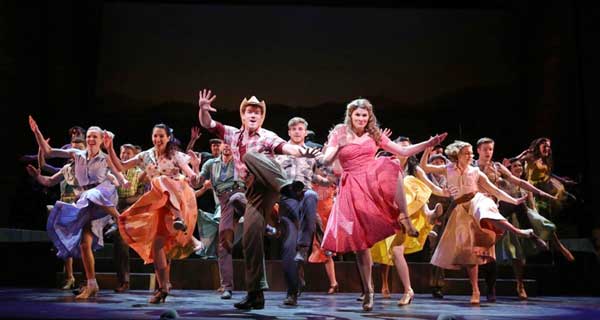The Most Happy Fella
Encores! At New York City Centre
6 April 2014
5 Stars
If you remember what it was like the first time you saw the sun rise, or saw your child smile, or beheld Michelangelo’s statue of David, or truly fell in love, or understood a piece of poetry or a Shakespearean sonnet, then you recall a moment of absolute, unfettered bliss, or incalculable joy, of permanent all-encompassing pleasure. That feeling, that unfeasibly pure and exhilarating adrenalin shot of ecstasy, was shared this evening by the hundreds of people who packed the New York City Centre for the final performance of The Encores! production of Frank Loesser’s extraordinary musical The Most Happy Fella.
Directed and choreographed by Casey Nicholaw, with musical direction by Rob Berman, this was a concert adaptation (by the indefatigable Bill Rosenfield) of the 1956 musical. Time will tell, but it may be that this concert presentation transforms this work in the eyes of the public in much the same way the 1985 Lincoln Centre Concert of Sondheim’s Follies revitalised public opinion about that work.
Because, without any doubt of any kind whatever, this performance ranks in the top five of the greatest live performances of musical works I have ever seen. It was, unquestionably, miraculous.
It is difficult to think of a single way in which the work done here could have been improved.
There are three key reasons for the success here.
Firstly, the casting is impeccable. Every single member of the very large cast was exactly right, in every way, for their role. All could sing, dance and act with ease and consummate skill.
Secondly, every single person was committed to the work and the vision for its presentation. All the performances were honest, true and engaged with each other. There were no “stars” here, although there were many life changing performances. It was a cohesive team effort, true ensemble playing.
Thirdly, no attempt was made to sing the music in other than the correct style. Rather than the current fashion for white sound or high belts or catch-in-the-throat delivery, every single person sang with properly produced sound, with their trained voice in full engagement, with legato and rubato and panache.
The result was utterly engaging, hilarious and touching in equal measure; a true triumph for the musical form.
The story concerns Tony, a shy Italian who falls for a waitress he is afraid to speak to; her writes a love letter on the menu and leaves her an amethyst tie-pin as a tip. He dubs the waitress Rosabella and they write to each other. She sends him his picture and he sends her a picture of his very handsome foreman because he is afraid she will not come to visit him if he sends his own picture. She comes and, understandably, thinks she has been tricked. She goes to leave but Tony has a car accident and is injured. Afraid he is going to die, he insists she marry him. What follows, provides the grist for Act Two.
It’s a very human, very ordinary tale of love and misunderstanding. What is extraordinary about Loesser’s work is that this is almost sung-through and the music is used to create, frame and advance the narrative of the characters. The songs are not important because they are songs, but because of how they advance the narrative or define the characters.
The show’s most famous song, Standing On The Corner, is important not because of its tune, but because of the story the song tells and the insight it gives into the four men who sing it, particularly Jay Armstrong Johnson’s dim but happy Herman. This is true of every song in the show; nothing is here for ornamentation. Every song adds colour, lustre, depth and shape to the characters and situation.
There are many rousing ensemble numbers, some funny and some achingly beautiful. Big D is one of the best production numbers in any musical anywhere and here it was given full show-stopping treatment. Song of a Summer Night stopped the show a different way – with evocative, glorious harmonies from the ensemble echoing and enriching the fine lead tenor from Kevin Vortmann’s Doctor.
Cheyenne Jackson has never been better than here. As the nomadic drifter Joe, he brought both his matinee idol appearance and his strong baritone voice to full engagement. It’s a lusty, self-aware turn, full of insight and vigour. His duet with Rosabella, Don’t Cry, was an astonishingly delicate, but wildly potent, ending for Act One.
Laura Benanti and Shuler Hensler were perfection as Tony and Rosabella. Their big duet, My Heart Is So Full Of You, is Loesser’s finest love song and the pair excelled themselves in delivering it. Happy To Make Your Acquantiance showed their tender and blossoming love at a different stage of the spectrum of love and was comic and joyful in equal measure.
Rounding off the main principal cast, but in no way “also-rans” were Heidi Bickenstaff (Cleo, Rosabella’s best friend) and her slow-witted, big-hearted always content beau, Herman. Their scenes together provided electrically charged comic bolts of pleasure: I Made A Fist being one of the funniest character-driven songs in musical theatre history.
Jessica Molaskey was tremendous as Tony’s dour unfriendly sister and the comic trio of Zachary James, Bradley Dean and Brian Cali provided comic relief of the tenor kind; Abbondanza and Benvenuta were numbers of unrestrained allure.
The specialist dancers did marvellously athletic and dynamic work. Nicholaw certainly knows how to choreograph and the dancers all did him proud, especially in the big number: Big D. Virile and enchanting, the effects were spine-tingling. This was true of small moments too: the choreography in Standing On The Corner spoke volumes about the four men singing the number.
Perfectly cast, directed, performed, sung and danced, this production will go down in history. It is now the new bench-mark for concert performances of great musicals.
Absolute perfection in musical theatre.

